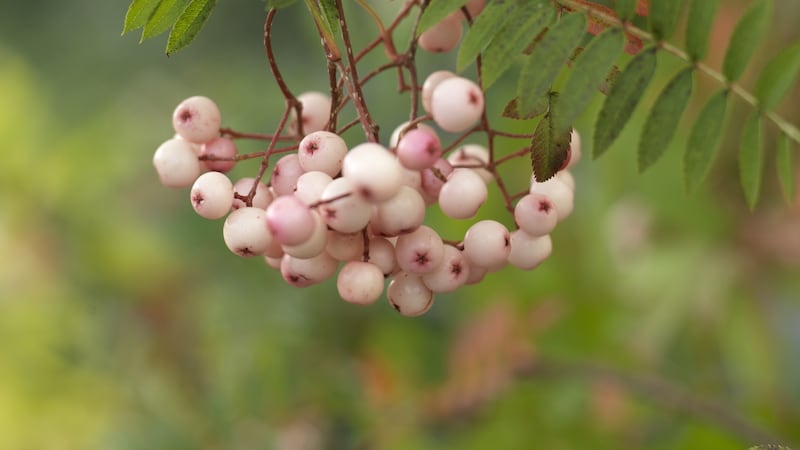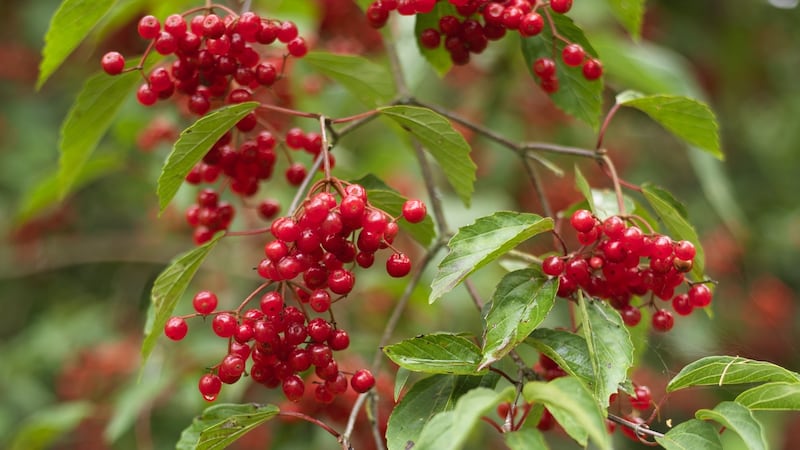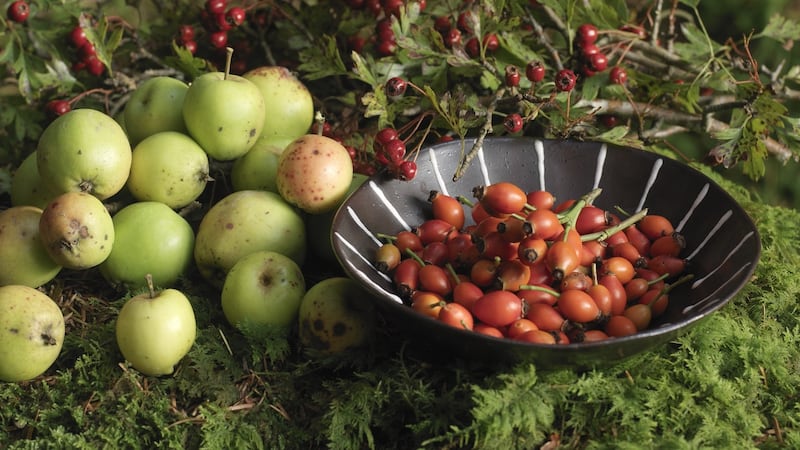As gardeners, we can sometimes be so enthralled by the spectacle of autumn leaves in all their fierce, fiery beauty that we don’t fully appreciate the other seasonal charms of this time of year. Not least of these are deciduous trees and shrubs with decorative fruit or berries, many of which remain on their branches long after the very last of those gilded autumn leaves has fallen. These are the plants that shine throughout the small, grey days of early winter, their glimmering, pared-back beauty underscored by the seasonal decay that surrounds them. Many are also excellent sources of food for wild birds at a time when it’s badly needed, while the fruit of some can be used to make health-enhancing tonics, jams or homemade wines. Last but not least, their cut branches look great brought indoors and arranged in a large vase or urn, reminding us that seasonal beauty comes in many different forms. Here’s a shortlist of some of the best.

1. Sorbus vilmorinii (Vilmorin Rowan). While there are many different kinds of rowan tree with spectacular displays of autumn berries, this species stands out for the painterly shades of its dangling clusters of ornamental fruits, which slowly fade from crimson-red to rose-pink and then almost white as the season progresses. Its berries also last well into winter unlike those of some other rowans. A great choice for a small garden, this deciduous tree is also valued for its pollinator-friendly spring blossom, scarlet autumn foliage and compact growth habit. Reaching an average height and spread of 4-5 metres over 20 years, it makes an outstanding specimen tree for a small garden.

2. Sometimes we ignore the obvious. So if I told you that our native hawthorn (Crataegus monogyna) was one of the hardiest, most versatile, supremely decorative, easy-to-cultivate, wildlife-friendly shrubs/small trees that you could grow, would you believe me? No? Just consider its pretty, pollinator-friendly spring blossom, its ability to flourish in the most hostile of conditions and those wonderful, scarlet berries that cover its spiny branches at this time of year. Plus those same berries are not just beautiful but as our forebears knew, they're also edible and health-enhancing. Use them to make a vitamin-rich, flu-fighting winter tonic. Alternatively, eat them in early winter, plucked straight from the tree and at that point of perfect ripeness that the British nature writer Richard Mabey describes them as tasting "like miniature avocados". But if that doesn't rock your boat, then seek out its close relative, the very decorative plum-leafed hawthorn, Crataegus persimilis 'Prunifolia'.
3. There's something about the zingy-coloured, winged fruits of Euonymus europaeus (our native spindle tree) that makes you want to stroke them while simultaneously marvelling at how their fizzy shades of bubblegum-pink and Fanta-orange should clash violently yet somehow don't. One of the best forms is Euonymus 'Red Cascade', which is much more generously fruiting than the species. Forming a small tree or medium sized shrub (3m by 2.5m), it's happy in full sun/light shade and in well-drained soil and is also prized for its vibrant autumn foliage and pollinator-friendly spring flowers. Once fully ripe, birds also love to eat the bright orange seeds. Grow it in a mixed border, as part of an informal hedge or in the wilder margins of the garden.
4. Malus 'Butterball'. There are many different varieties of ornamental crabapple that deserve a place in the autumn/winter garden for their long-lasting, colourful displays of showy fruit. This particular one is prized for its especially abundant display of miniature rose-gold apples that ripen in autumn and persist on the branches well into winter. As what's known as a universal pollinator, it's also a great addition to a mini apple orchard (a universal pollinator makes for better harvests) while those ornamental fruits can be used to make a delicious crabapple jelly. The fact that its long lasting, pretty, pale-pink spring blossom is adored by pollinating insects is yet another reason why this compact, deciduous tree (4m by 4m) is great choice for the smaller garden as long as you give it full sun or light shade and a fertile, free draining soil.
5. As long as you don't deadhead them, many species of rose have exceptionally decorative, bird-friendly, edible hips that glow in the late autumn garden and can also be used to make a nourishing syrup or jam (see This Week in the Garden). Examples include Rosa spinosissima, Rosa moyesii, Rosa rugosa, Rosa canina, Rosa macophylla, Rosa macrantha and the hybrid musk rose, Rosa 'Penelope'.

6. Known as the tea viburnum, Viburnum setigerum's extravagant display of bright scarlet berries in autumn and early winter can often be so heavy that they weigh down its slender, arching branches. Forming a medium-sized, spreading shrub (2.5-4m by 1.5-2m), this hardy plant is also prized for its golden/crimson autumn foliage and its small but pollinator-friendly spring flowers. For the best display of fruits, it's a good idea to plant it as a small group to aid cross-pollination. Happy in full sun or light shade and an acid/neutral, moist but free-draining soil, the tea viburnum gets its common name from the fact that Buddhist monks of Mount Omei in China traditionally used its leaves to make a sweet medicinal tea. Its close relative Viburnum betulifolium forms a larger, more upright plant (3m by 3m) and produces a similarly eye-catching , long-lasting display of brilliant scarlet berries that endures for many months after the leaves have fallen.
This Week in the Garden
The decorative deciduous, self-clinging climbers known as Boston ivy (Parthenocissus tricuspidata) and Virginia creeper (Parthenocissus quinquifolia) are in full autumn colour now, their crimson leaves creating a spectacular seasonal display that few other plants can rival. The classic spot to grow them is against a high, sunny house wall but it’s important to bear in mind that both species are hugely vigorous, fast-growing plants that can eventually reach a great height and spread and need regular pruning to keep them from obscuring windows, blocking gutters and dislodging roof tiles. So if you don’t fancy the idea of balancing on a tall ladder while wielding a secateurs/shears, you’ll need to persuade or pay someone else to do it for you. The best time to prune both Boston ivy and Virginia creeper is after the leaves have fallen and before the end of the year.

Harvest ripe rose hips and use them to make a tasty, health-enhancing syrup that's naturally rich in vitamins A, E and C and can be used to help stave off winter coughs and colds. For a copy of the recipe originally issued by the UK Ministry of Food during the second World War for exactly this purpose, see recipespastandpresent.org.uk. Its health boosting qualities aside, rosehip syrup has a very pleasant, fruity "hedgerow" flavour and can be used to make a cordial, added to an autumn cocktail, drizzled over pancakes or ice-cream. The hips can also used to make a flavoursome, nutritious jam or marmalade.
Read this: Beautifully written and acutely observed, Scent Magic: Notes from a Gardener by the English garden designer and plantsperson Isabel Bannerman is destined to become a gardening classic. Published by Pimpernel Press (£30), this calendar of smells will make you want to grow Pelargonium tomentosum just to experience the sweet whiff of "caramelised mint humbugs" that comes from its felty leaves, to seek out a Camellia sasanqua in full bloom to suck in its perfume "fine as a petal, light as orange flower water" and to drink in the smell of autumn when the air is "rich with the nutty, fruitful, verdant herbage of acorns crushed in tarmac and a million leaves descending". Its sensuous charms aside, the author is also fascinating on the science of smell, from how it subconsciously informs us about our surroundings and the people around us to how air pollution is destroying plant fragrance by as much as 90 per cent with dramatic consequences for insects and birdlife. A must-read.
Dates For Your Diary
Saturday, October 26th-Monday, October 28th, 11am-4pm, Killruddery House & Gardens, Bray, Co Wicklow, Halloween seasonal celebrations including pumpkin carving, scarecrow-making and more, see killruddery.com for details/to pre-book; Continuing until October 31st at the National Botanic Gardens, Glanevin, Dublin 9, Magical Plants, a drop-by event for children that takes a seasonal look at some of "the world's weird, wonderful and magical plants from the famous wolfsbane of Harry Potter to the opium poppies of the ancient Egyptians". See botanicgardens.ie





















